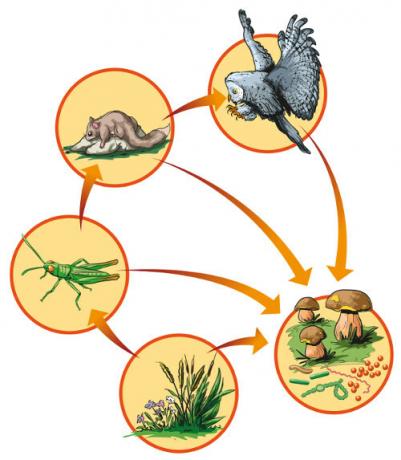Food chain is a sequence of living beings in which one serves as food for another. On this route, the energy and matter of food are transferred from one level to another. Each living being is essential to the food chain, and the elimination of one of these organisms in the ecosystem can lead to environmental imbalance, affecting the entire chain.
Trophic levels of the food chain
In food chains, we observe the feeding relationship between different living beings in an ecosystem. The position each living being occupies in this chain is called trophic level. Producers, consumers and decomposers are the different trophic levels observed in this scheme.

Producers
You producer bodies are the first trophic level observed in a food chain. Organisms at this level are classified as autotrophic, that is, they are living beings capable of producing their own food, and it is not necessary to feed on another living being. At plants and seaweed are organisms classified as producers.
know more: Photosynthesis: energy capture and transformation process carried out by producing organisms
Consumers
You consumers, as the name implies, they are living beings that feed on other living beings to get the energy and nutrients necessary for their survival. Consumer bodies are therefore heterotrophs.
Consumer bodies can be further classified into primary, secondary, tertiary, quaternary and so on. However, it is important to note that the chains tend not to be very large, with five or fewer links being generally observed. Among the hypotheses that explain why the chains do not extend far is the energetic hypothesis, which suggests that size is limited due to low energy transfer efficiency.
Primary consumers are those who feed on the producer. In the above scheme, the primary consumer is the grasshopper. The organism that feeds on the primary consumer is called the secondary consumer. In the example, this is the frog. The tertiary consumer is the one who feeds on the secondary, as is the case of the snake feeding on the frog. If, in the example, some organism was feeding on the tertiary consumer, this would be called the quaternary consumer, and so on.
Decomposers

You decomposers are organisms that participate in the food chain carrying out the decomposition of organic matter, and act on all trophic levels. Like consumers, decomposers are heterotrophs. Examples of decomposing organisms are the fungiand the bacteria.
Know more: garbage decomposition time
Energy flow in the food chain
Most of the energy that enters an ecosystem comes from the solar radiation. The producer organizations that carry out photosynthesis absorb solar energy and fix it in chemical energy. When consumers feed from producers, part of this energy goes to these organisms, which, when serving as food for other living beings, also pass part of the energy to them. This, therefore, flows, in a unidirectional sense, passing from a lower level to a higher one.
THE each level, however, there is a loss of some energy. Plants, for example, transform solar energy into chemical, but use part of this initial energy for the breathing process. So only part of it will be available to the next level, which is one of the reasons food chains don't stretch very far.
food chain and web
When we talk about food chains, we are referring to a sequence of living beings that serve as food for others. THEWeb, in turn, is the connectionof food chains. Webs are a better way to understand the functioning of an ecosystem, since an organism, in most cases, does not have just one type of prey.
Another important point to be highlighted is that, when analyzing a food chain, we find that a living being occupies only a specific trophic level. In the food web, in turn, the same organism can occupy different levels. The animals omnivores, for example, when feeding on vegetables, they are classified as primary consumers and, when feeding on herbivores, as secondary consumers. If you are more interested in the subject, read our text: food chain and web.

Know more:What is a food chain?
How the introduction and extinction of species affect the food chain
Food chains show the food relationships that exist in a given ecosystem. When a new species is added to this location, it can cause imbalances in the environment. If it does not find food available in that region, it can quickly die and be eliminated. If it finds it, it can trigger the competition with another living being, which is detrimental to the balance of the ecosystem.
This new introduced species may also have no natural predators and multiply excessively, if the environment is favorable, which can lead to a drastic reduction of their prey. Therefore, we found that the introduction of a new species can negatively affect feeding relationships in that location.
Another known situation is the extinction of a species. Let's imagine, for example, a simple food chain that involves a plant, a rodent, a snake and a hawk. If the snake is eliminated from the environment, the hawk will be without food. On the other hand, the rodent can multiply in an excessive way, due to the lack of predators, which can cause the reduction of plants in the place. Over time, the reduction in the number of plants will also impact the rodent, which will run out of food. We can see, therefore, that each living being is essential for the balance of the ecosystem.
Read too: Endangered species
By Ma. Vanessa Sardinha dos Santos
Source: Brazil School - https://brasilescola.uol.com.br/biologia/cadeia-alimentar.htm
